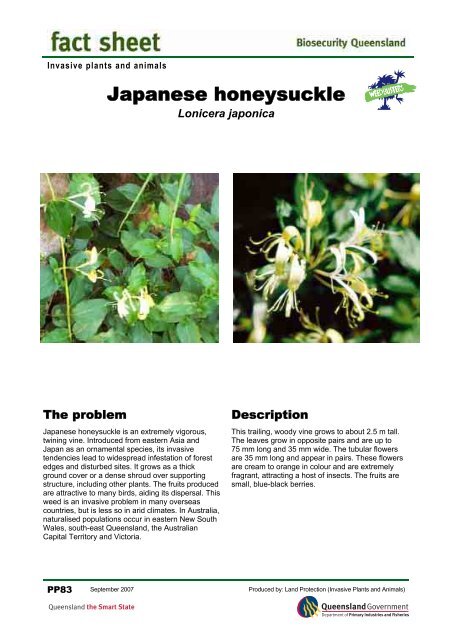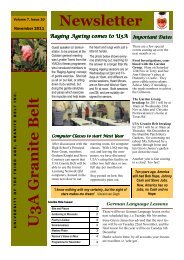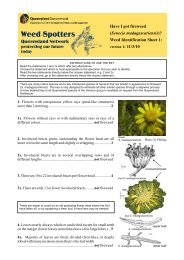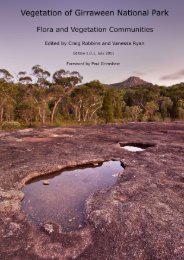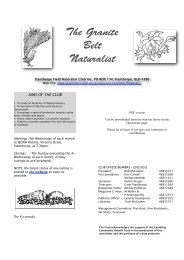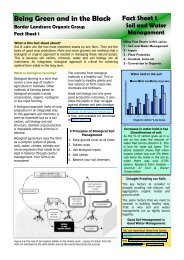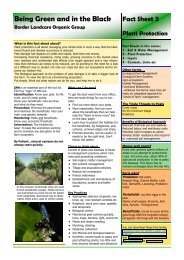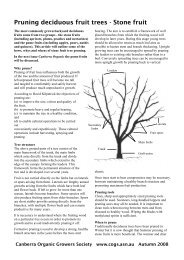Japanese honeysuckle
Japanese honeysuckle
Japanese honeysuckle
You also want an ePaper? Increase the reach of your titles
YUMPU automatically turns print PDFs into web optimized ePapers that Google loves.
Invasive plants and animals<strong>Japanese</strong> <strong>honeysuckle</strong>Lonicera japonicaThe problem<strong>Japanese</strong> <strong>honeysuckle</strong> is an extremely vigorous,twining vine. Introduced from eastern Asia andJapan as an ornamental species, its invasivetendencies lead to widespread infestation of forestedges and disturbed sites. It grows as a thickground cover or a dense shroud over supportingstructure, including other plants. The fruits producedare attractive to many birds, aiding its dispersal. Thisweed is an invasive problem in many overseascountries, but is less so in arid climates. In Australia,naturalised populations occur in eastern New SouthWales, south-east Queensland, the AustralianCapital Territory and Victoria.DescriptionThis trailing, woody vine grows to about 2.5 m tall.The leaves grow in opposite pairs and are up to75 mm long and 35 mm wide. The tubular flowersare 35 mm long and appear in pairs. These flowersare cream to orange in colour and are extremelyfragrant, attracting a host of insects. The fruits aresmall, blue-black berries.PP83 September 2007 Produced by: Land Protection (Invasive Plants and Animals)Queensland the Smart State
Management strategiesThis weed can be manually controlled by handpulling or cutting it back. Take care to completelyremove the roots (particularly larger roots) or theplant will regenerate vigorously..Declaration details<strong>Japanese</strong> <strong>honeysuckle</strong> is not a declared plant underthe Land Protection (Pest and Stock RouteManagement) Act 2002, however, plants that are notdeclared under state legislation may have controlrequirements imposed by local governments.Further informationFurther information is available from the vegetationmanagement/weed control/environmental staff at yourlocal government.TABLE 1 − HERBICIDES REGISTERED FOR THE CONTROL OF JAPANESE HONEYSUCKLEMethod Herbicide Rate Registration status CommentsFoliarapplicationglyphosate (360 g/L) 10 mL per 1 L PERMIT 7485 Apply up to twice a year. Applyonly when supporting plant andunderstorey are dead.Apply early autumn (March-April).Do not spray beyond the point ofrun-off.Cut stump glyphosate (360 g/L) 10 mL in 20 mL water PERMIT 7485 Apply in spring to summer.Apply second application ifnecessary.Cut stumppicloram (43 g/kg)e.g. Vigilant®Apply 3−5 mm thickover the cut surface(20 mm in diameter)In multi-stem planttreat at least 80% ofstems.Read the label carefully before use and always use the herbicide in accordance with the directions on the label.It is a requirement of a permit that all persons using the products covered by this off-label permit comply with the details and conditionslisted in the permit. In addition, read the herbicide label carefully before use and always use the herbicide in accordance with labeldirections. The above permit can be used by pest control operations, members of environmental groups such as Bushcare, Catchment Care,Coast Care and people employed as or working under supervision of local and state government officers.Fact sheets are available from DPI&F service centres and the DPI&F Information Centre phone (13 25 23). Check our web site to ensure you have the latest version of this fact sheet. The control methods referred to in this Pest Fact should beused in accordance with the restrictions (federal and state legislation and local government laws) directly or indirectly related to eachcontrol method. These restrictions may prevent the utilisation of one or more of the methods referred to, depending on individualcircumstances. While every care is taken to ensure the accuracy of this information, the Department of Primary Industries and Fisheriesdoes not invite reliance upon it, nor accept responsibility for any loss or damage caused by actions based on it.© The State of Queensland (Department of Primary Industries and Fisheries) 2007


